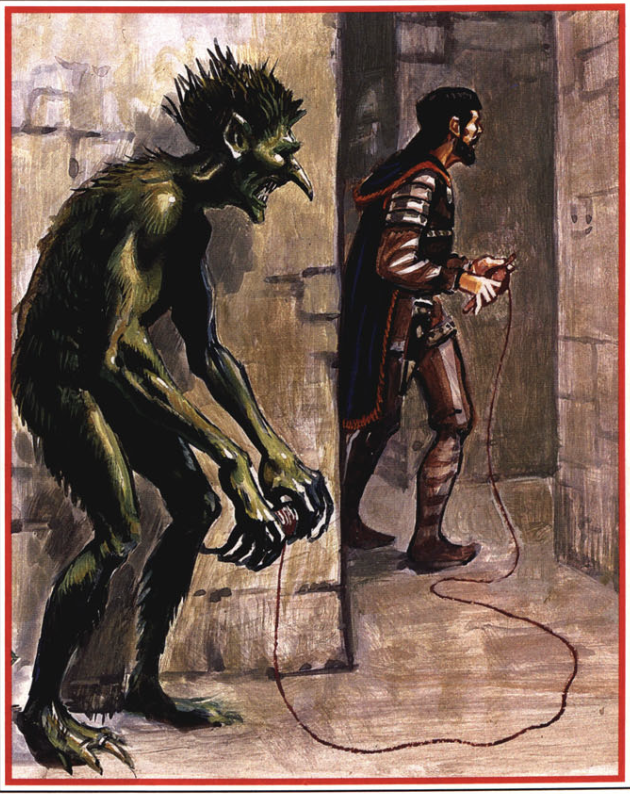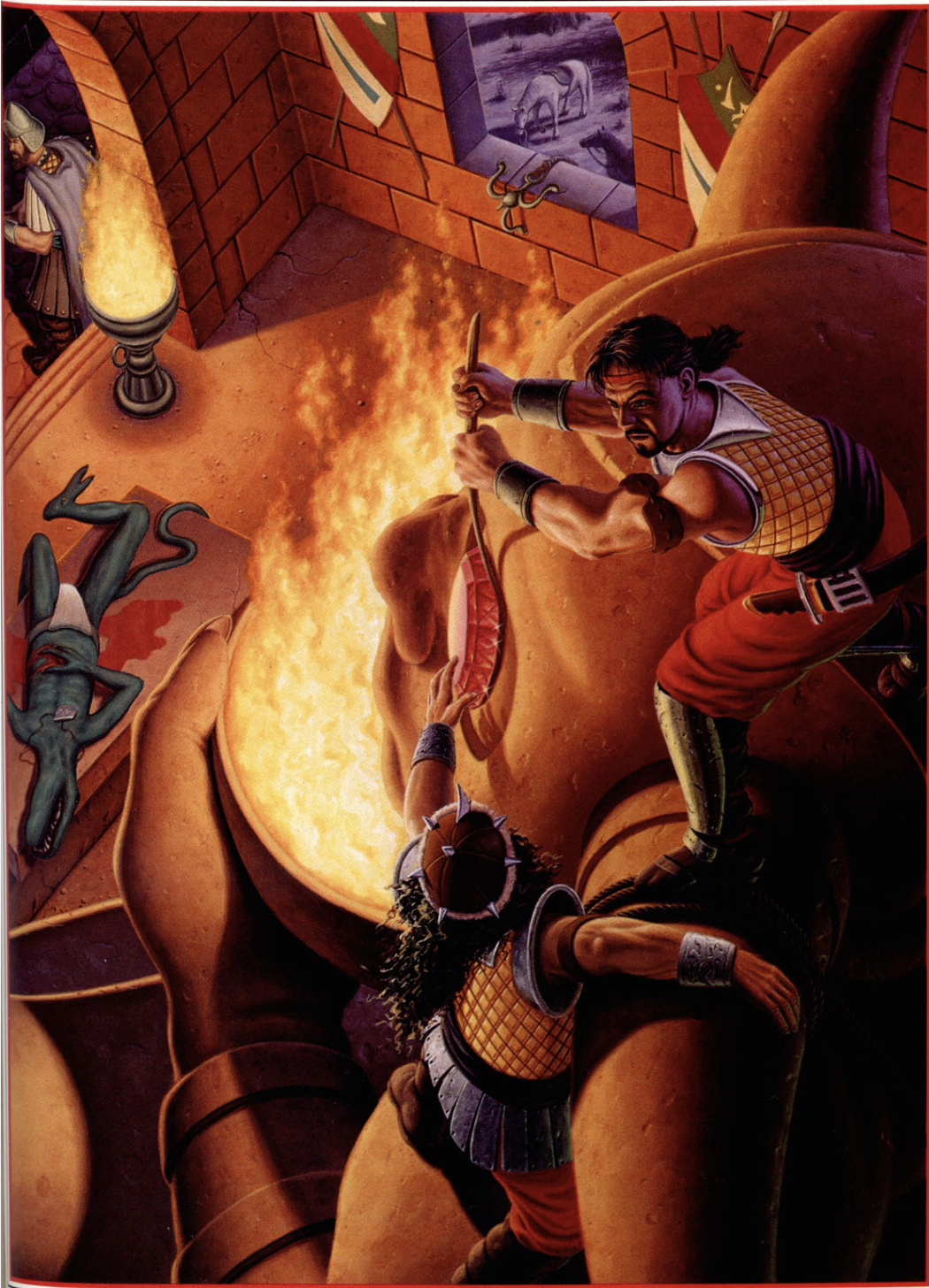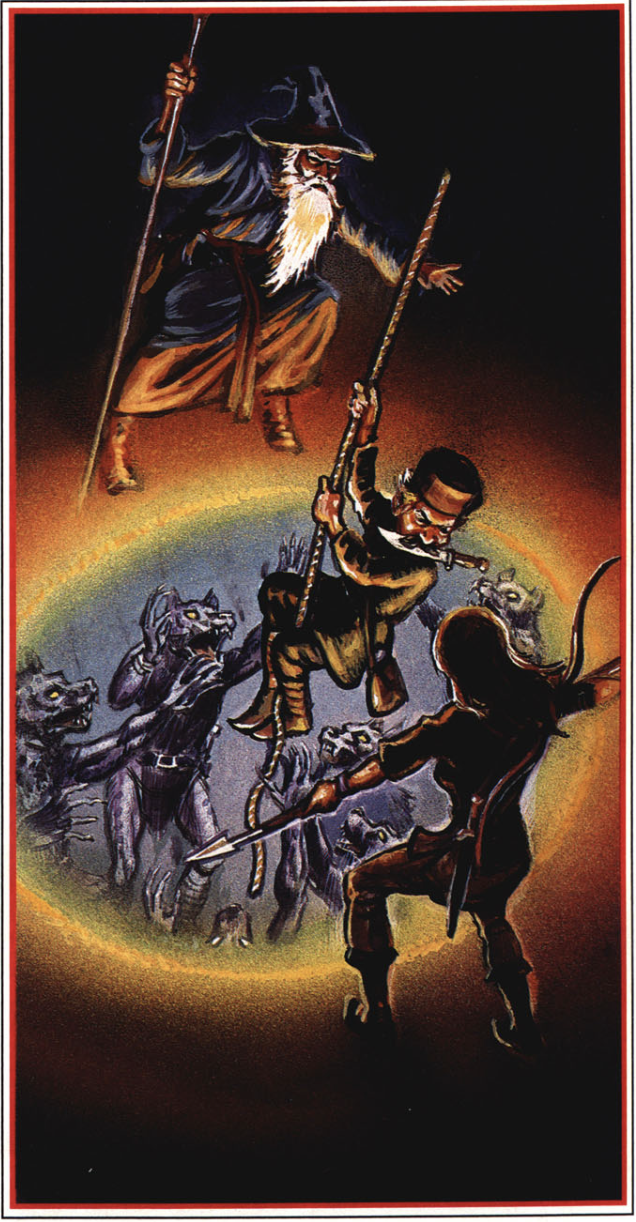Appraising ADVANCED D&D - Part 3 (Classes)
The AD&D appraisal show is back on the road. Today is about classes and it's a bit long, so here is the
tl;dr - a high level run-through and review of the classes, priests get the most attention, we look at the weird asymmetrical XP progression inherited from 1st edition where warriors are the slowest to advance from 7th to 14th level and wrap up with what racial requirements and certain classes means for the implied AD&D world.
Alright, let's get to it.
 |
| Don't tell me you seriously believed we were done showcasing art from the revised core rulebooks? |
Few things are more defining for a DnD game than its take on classes. And in 2e, we find probably the best take on it that has been done.
Presentation-wise, they are, finally, organised into the sensible class categories the game has been asking for ever since OD&D introduced the spuriously defined notion of 'sub-class':
- Warrior (Fighter, Ranger, Paladin)
- Wizard (Magic-User, Specialist)
- Priest (Cleric, Druid, Specialty Priest)
- Rogue (Thief, Bard)
9-10 classes, depending on how you look at it (I am not considering each branch of specialist wizard and specialty priest a separate class and druid is technically an example of specialty priest). A good number that gives a rich sense of choice without descending into decision paralysis or class spam.
 |
| dafuq...? |
This is where we see a significant diversion from the non-advanced Classic D&D. And significant improvement on 1e (the reasons for that got lengthy, so the next entry will focus solely on that).
Fighters are, honestly, a bit dull. They have nothing going for them compared to rangers and paladins and the XP break they get for that is not big enough to matter. If you use the optional weapon specialization rules, then they have that, which is a significant boost, but being dependent on an optional rule for your most iconic class being boosted is not good design (nevermind the fact that optional rules should not boost singular classes). They work, I suppose, but I feel like they should not require as much as XP as they do for what they get.
Paladins are paladins. Basically unchanged from 1e, hated and loved in equal measure for being over-powered warriors balanced only by their gametable-frustrating single-minded focus on virtue.
Then there are Rangers, and I do love me some ranger. A bit like bards, they always struck me as a class embodying adventure for the sake adventure, discovery and wonder.
They are good with animals, can track and get a few thief skills. For me, there's a conceptual gap in d&d between the fighter and the rogue - the Adventurer who is a hybrid of both. And the ranger comes closest to bridging that gap, albeit with a strict wilderness angle.
Then they also get priest spells at 9th level, which always struck me as a bit odd. Why? Are they divinely appointed champions? Pseudo-druids? In the examples from fiction ("Robin Hood, Orion, Jack the giant killer, and the huntresses of Diana" where is Aragorn, the actual inspiration?), only the huntresses of Diana gives any indication of why they might get priest spells. Perhaps they are not pseudo-druids as much as favoured children of the goddess of the hunt...
Rangers getting priest spells is one of those oddities that D&D ever since has fought hard to never try to explain or situate in the implied world of D&D. WHY DO THEY GET PRIEST SPELLS, MIKE MEARLS? MONTE? ZEB? No one can say.
 |
| A nice little homage to an earlier edition. Neat. |
Next up, wizards. magic-users have been suitably re-named "mages" and they work as you would expect them to. And that brings us to Specialist wizards.
Seriously, Zeb and co, why did you even bother? "Let's make a variant spellcaster. And let's distinguish them by.... giving them an extra spell slot per level for one school and barring them from two other schools."
When people complain about the homogenised class design in 2e, it's because of specialist wizards. The most boring and uninventive of classes, possibly across all editions of D&D. Boooooooo.
 |
| Behold. My two-dimensional class design allows me to pass through even the narrowest of passages. |
Skipping quickly on to a more interesting topic - Priests!
Ahh, the Cleric. Ever the most overpowered class for the least amount of XP. Balanced only by the fact that no one wants to play one, because they always get reduced to healbots with limited agency and their conceptual niche is stolen by the Paladin anyway.
They are a solid enough build in 2e, although I take issue with the spell list now overlapping too much with the druids. Where I feel 2e missed a trick is the fact that 2e provided a conceptual framework for the cleric that was missing all along and never utilised.
Specialty priests or Priests of Specific Mythoi as the PHB so elegantly calls them. Which is a framework for "do-it-yourself" priests, enabling you to craft priests suitably representing any kind of deity, so we avoid the weird situation where the vengeful god of light has clerics, so does the pacifist goddess of love and the trickster god of thieving, etc. The cleric was a specialty priest of a certain type of deity all along.
Unfortunately the creators of 2e weren't emphatic enough in establishing that this is clearly the case. So when 3e/4e/5e rolled on, we did indeed go back to the goddess of fucking having clerics in heavy plate mail turning undead, because fuck you.
Anyway, 2e had a very nice framework for this - categorising priest spells into spheres. Now your priests will only cast spells that are thematically appropriate. thank you. And also, they don't need to turn undead. They can have different granted powers, like Charm, inspire fear or berserker rage. And yes, they can have a different narrow set of religious weapons available to them besides blunt weapons.
The Player's Handbook is a bit light on the how of it, but the Complete Priest's Handbook is not and provides a thorough guide for this, including whether your speciality priests should be mutilated as part of their initiation and how some might have d4 for HD, etc. Good stuff. Specialty priests are perhaps the best contribution 2e brings to D&D classwork and it's a disappointment to see how it's been thoroughly overlooked since.
Druids are are perhaps the most interesting class in the PHB. They are the sample specialty priest and, being altogether different from the cleric, gives the DM a good idea of just how far one can take the specialty priest concept.One of the more interesting thing about the druids is their XP progression. They need only 300k to get to 12th lvl (Druid), the fastest progression of any class (fighters are still only 9th lvl at 300k and rogues, the next fastest, need 440k for 12th lvl). Then a whopping 750k for 13th lvl (arch druid) and by the time they get the 3m XP for 15th level (grand druid), everyone else will be 18-20+ lvl.
Of course, the big thing here is that to advance to 12th lvl, and up to 15th, there must be an opening in the small ranks of existing druids of that level (and there is only ever one 15th lvl druid around). And if you don't feel like waiting for that opening to happen organically, single combat is the only way to go.
But it's also interesting since the Grand Druid for example, has six agents of levels 7 to 11 who receive extra spell levels as the Grand Druid's agents. And a Grand druid title is never won by combat, but chosen. So basically, the only way to advance is to become the favoured choice of the existing grand druid. We're also told that anyone adventurous will not remain grand druid any longer than need be, due to the onerous responsibilities. So one may assume it's not a longheld office in general.
But overall, the druid's XP table is primed to get them to 12th lvl ASAP and then the slog of higher XP and political machination and advancement through a limited hierarchy begin.
 |
| I... I... I think I like this piece. |
Looking at the Druid's XP table inspired me to line up and compare XP totals per level for all classes. Lowest total pr level is marked in green, highest in red:
The other thing that stands out is how from 6th to 14th lvl, Warriors are the slowest to advance. It's a bit odd and I don't know why they went that way. Wizards are actually only the slowest from 2nd to 6th lvl and at points can be two levels ahead of Warriors with similar XP.
These tables are basically the same as in 1st edition, which perhaps goes some way to explain the asymmetrical nature of them (more on this when we visit the 1e bard in the next episode).
 |
| Another homage. Never noticed before that the revised DMG actually has a well-done homage to the 1e Player's Handbook from a new angle. |
MOVING ON....
They are basically the OD&D Elf, rendered as an AD&D class. Want to dress up as a knight and fight today? You can. Want to be a spellcaster tomorrow? You can. Their generous XP progression means that your Bard can be 11th level whilst the fighter is still only 8th level and the mage 9th. Your THAC0 is 2 points behind the fighter and your spellcasting only one level lower (4th) than than the mage. They are second-best in many categories, but in a way that packs enough of a punch to matter.
Let's dwell a bit on racial requirements and what that might say about the implied world of AD&D.
Why are rangers elf, half-elf and human only?
We could perhaps say that no other races have affinity for it, but rangers are one of those classes with a somewhat eclectic skillset (fully trained warriors, with woodland abilities, spellcasting and special affinity with two-weapon fighting, plus alignment requirements) that it suggests to me that Ranger is more like a lineage tradition (as opposed to an organisation) than just 'woodland warrior'.
Which suggests to me to me that at some point, there was a compact between elves and men, from which an order of borderland fighters emerged, that accepted membership from both sides. Was it a marches order, that maintained the buffer zone wild marches between human and elven lands? Or perhaps a realm incorporating both men and elves.
Wizards likewise. Elves invented it and taught it to humans and that is it. Others aren't invited to the party. The elves probably regret that bit.
Why are druids human and half-elf only? Why bards likewise?
We can perhaps say that these are simply human classes (see my previous post on a possible in-world rationale for bards). But it does make me wonder - why are elves not allowed as druids? It seems a shoe-in for the sylvan species to also have druids in their ranks, but this is not the case.
Well, druids stand out among the classes, in that they are the only core class explicitly situated in the world, with a religious order and hierarchy attached, powers only available to druids (shapeshifting). So we know that "druid" is not just a catch-all for sylvan priests of all stripes, but a very specific kind of priest that only exists within the order of druids. One that doesn't seem to worship any gods, but protect the cycles of nature.
And they are explicitly neutral. The Balance. I always saw druids as having a very particular interpretation of neutrality. One perhaps, that does not sit well with elves in general.
 |
| After a few good pieces in this entry, of course we will end this with another awful one. |
The existence of Hierophant druids is another element with setting impact. 16th+ level druids are basically immortal shapeshifters who can, without using magic (and thus undetectable to anything but True Seeing) change their appearance at will, including impersonation (even as children). And at 17th lvl they can hibernate, basically indefinitely, based on certain triggers.
That seems like a wicked group of high level spellcasters to have running around the game world as free agents of the cyclical balance of nature. You can never know how they look, they can be be old as fuck, or, if tired of hanging around, just hibernate until some events requiring their attention happens. This seems like a recipe for a lot of covert Neutral operations, which can be planned out on the scale of decades and even centuries. I somewhat expect to find that hierophant druids are often the real reason certain empires, those who tipped the scales of law and chaos a bit too much, are toppled.








Great post!
ReplyDeleteIIRC the ranger has priest spells because Aragorn could cure people.
Those XP progression are bonkers, specially the druid.
I always assumed that the original intent behind rangers getting priest spells was to mechanically represent herblore and the like - think Aragorn using athelas on the hobbits - but that later editions took it literally and started letting them throw around divine miracles.
ReplyDelete> So when 3e/4e/5e rolled on, we did indeed go back to the goddess of fucking having clerics in heavy plate mail turning undead, because fuck you.
ReplyDelete5e really doesn't do this - only maybe half of all clerics can use heavy armour; the difference in feeling between a light cleric (pew pew the undead), a life cleric (healbot max), a knowledge cleric (skill monkey with identify?), and a trickster cleric (stealth blessings!) in the party is pretty serious. Certainly not as much difference as you _can_ get with specialty priests in 2e, but it's laid out there in the rules & maps moderately well onto custom worldbuilding.
Its still clerics of fucking going around in half plate, shield and mace, turning undead, making divine strikes and everybody casting from the same spell list, with a few possible additions from one's domain.
DeleteThe druid is the baseline of differentiated priestly classes, as the sample "priest of a specific mythos" in the 2e PHB. Domains in 5e are basically at the kit level of differentiation.
Which could perhaps have been ok, except it is bolted on to a very specific martial Pseudo Christian specialty priest called clerics.
Given how much shit I give 2e for its dull implementation of specialty wizards, I am not inclined to feeling generous towards 5e's equally monotonous implementation of priesthoods.